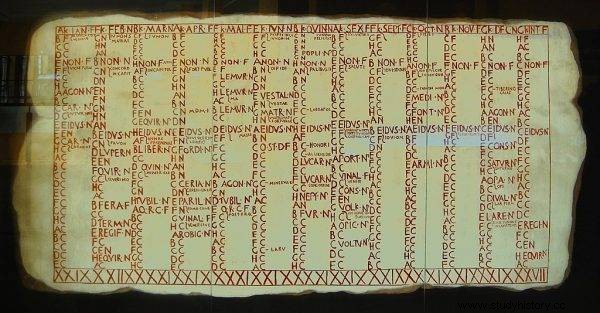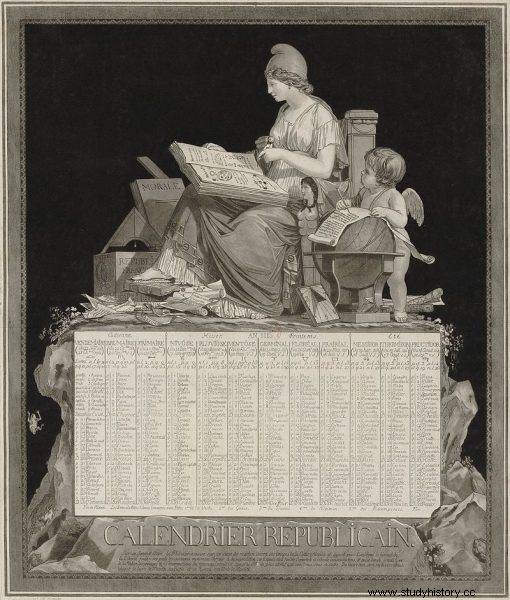Calendar is a contractual tool - just like time and its counting. However, let us leave the physical issues alone, and deal with the historical ones. Has the New Year always started on the first day of January?
In different cultures, time is counted from another important event, in most cases legendary (but not always!). They were most willingly started from the beginning of the world or some breakthrough - the death or birth of important people, e.g. rulers.
Time is measured by chronology (divided into mathematical / astronomical and technical, i.e. historical). It is one of the auxiliary sciences of history. It is also very extensive, so in this article I will focus only on the so-called starting styles and eras.
Calendars and eras
Calendars can be divided into several types. The dependence is obviously related to the observation of certain phenomena (mainly astronomical), such as the Moon's cycle or the apparent movement of the Sun in the sky. Certain repeating cycles divide larger units of time into smaller ones - year into months, these in turn into days, etc.
Calendars are divided into solar / solar (e.g. Mayan, Aztec, as well as Julian and present-Gregorian), lunar / lunar (e.g. Roman, Muslim, Babylonian or Ancient Greek), lunar-solar (e.g. Egyptian) calendars. The count of time can also be determined on the basis of the so-called the short (cyclic) or long (linear) era. The former can be counted from the cycles (of various lengths expressed in years, months or the period of the ruler's reign), while the long era is counted from some important event.
For example, in the Gregorian calendar - from the birth of Jesus (according to the calculations of the monk Dionysius the Little, who assumed that Christ was born 753 years after the founding of Rome; it is assumed that this date is incorrect, and Jesus was actually born between 4 and 6 BC) . The Byzantine era, on the other hand, counts from the creation of the world (5509 BC), as does the Alexandrian (5493 BC) and the Jewish (3761 BC). The first date is related to the Byzantine tradition, the other two to the calculations of (respectively) the Egyptian monks Panodoros and Anonnios, who lived in the 5th century, and Rabbi Hillel II the Younger in the 4th century.

Reproduction of the Roman Fasti Antiates calendar before Caesar's reform
The Muslim era is counted from the escape of Muhammad from Mecca to Medina (Hijra), i.e. from 622, the Buddhist era begins with the death of the Buddha (624 BCE or 560 BCE). the era of the martyrs that begins in AD 284 and is still used by the Ethiopian and Coptic Churches (this date determines the accession to the throne of Emperor Diocletian, who initiated massive persecution of Christians), as well as the so-called the era of the Olympics, which began its chronology with the first Olympic Games (776 BCE). Of course, these are not all eras (the so-called long) appearing in historiography.
Year Starting Styles
In the past, the term "year" for the period of time known to us today was not used. The word concerned the term ... appearing in court. The word "anno / annus", which we know, meaning the year, started to function only in the 16th century. Historians have a big conundrum about timing an event if the era used in a given culture does not correspond to the custom of starting the next year.
We will start with the most popular style, i.e. circumcision style. The year starts on January 1st (no wonder to us!). It was adopted by Christianity, but was in force before (it was put into use by Caesar). Why does the name contain a word that is hardly associated with the passage of time, and what is its origin? This, of course, is true of Jesus' circumcision, which the Bible says would take place eight days after his birth. In the Polish-Lithuanian Commonwealth, this style was rare, and in other countries it was common only from the 16th century (e.g. in France from 1567).
The Easter style, also known as French, assumed the beginning of the year in accordance with a holiday that (horror of horrors!) Is movable. So the year could start from March 22 to April 25 and have a different number of days. It was used in the West; from the ninth century in France, and also in the Netherlands - until the sixteenth century.
In Republican Rome, the style called March was used, which was recognized as the first day of the year on March 1. An interesting fact is that it was used in Venice until the end of the 18th century! Anyway, was often chosen for the first month of the year. For example, in the style of the Annunciation, the year would start on March 25. This style can be divided into two varieties - Pizza and Florentine. The latter was more popular, and it settled in England for a longer time (from the 13th to the mid-18th century).

The French Revolutionary Calendar for the Second Year (1793–1794)
The most common style used by most royal offices in the Middle Ages was the so-called the style of the Nativity of the Lord (Latin Nativitate ) in which the new year was counted from December 25. This method is considered to be the oldest in our area and the most common. Used until the reign of Jan Olbracht, who leaned towards the circumcision style (although the style of the Nativity of Christ was still used in the 16th century, e.g. in some city books).
An interesting style of calculating the new year was the revolutionary style that arose already in modern times . The years were counted from September 22, 1792 (the date of the establishment of the first republic) . Its design was developed by Gilbert Romme, and the names of the days and months were invented by a French politician, actor and poet - Philippe Fabre d'Églantine. This calendar kept the number of days in the Gregorian calendar, the difference was the division of the month into three decades of 10 days. The last one was a holiday. It was also planned to divide the day into 10 hours, an hour into 100 minutes, etc.
Each day had a name related to an animal, mineral, phenomenon, or tool. Months of their names came from simple terms, which mainly referred to atmospheric phenomena, e.g. Brumaire (French brume - dense fog), Thermidor (Greek thermos - hot) but also food products - Fructidor (Latin fructus - fruit).
On January 1, 1806, Napoleon restored the Gregorian calendar. The revolutionary calendar was introduced for a while during the so-called Of the Paris Commune (March 18 – May 28, 1871).
Bibliography:
- Cisek A., The Bastille Lie:sketches about the events and people of the Great French Revolution , Gdańsk 2011.
- Gajek B., What is time? , "Newsweek Historia" 2/2019.
- Opolski A., Calendar and its history , Wrocław 1948.
- Szymański J., Auxiliary sciences of history , Warsaw 2012.
- Włodarski B., Polish chronology , Warsaw 1957.
